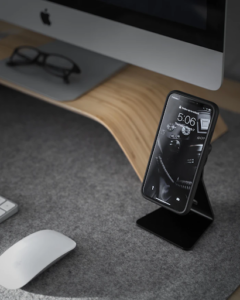Preventing Device Related Injuries
Most Americans use their smartphones multiple times per day. All that typing, swiping and pinching can put a strain on your hands, wrists, and even your neck. We all know we should type with our wrists raised when working on a computer, but what about proper phone posture? There are ways to be kind to your body while still using your device. Here are five hacks to help you text and tweet more comfortably:

-
Switch Fingers
Hand and wrist injuries have become more common as smartphones have surged in popularity. Most people use their thumbs to text and swipe with. The thumb is excellent for many things, but it’s not the most nimble finger. It is very easy to overuse the thumb in an average day of texting and surfing the web on your phone. Try switching to an index finger and switching between hands to prevent overusing any one finger.
Hand injuries happen most often when the texter is holding their phone with the same hand they are typing with. This puts the hand into an awkward position that strains tendons. Placing your phone on a table or holding it with your other hand can prevent injury.
When holding your device, try to keep your wrist as straight and relaxed as possible. If you must type with your thumb, make sure to use the pad of your thumb and not the tip. Scrunching your thumb to use the tip can injure tendons.

-
Use Technology
This might sound like strange advice, but our technology use can be made safer by more technology. Simple phone accessories can help minimize stress on your tendons and joints.
An easy to grip phone case will protect your phone and your hand by allowing you to ease your grip. Voice commands can help take some strain off of your fingers if you have to type a lengthy text or email. When voice commands are not an option (such as on public transportation) use a portable keyboard that connects wirelessly to your device.
If you spend long hours talking on your phone, use a headset. This will prevent elbow strain that can lead to cubital tunnel syndrome, also known as cell phone elbow. If you spend a lot of time watching videos on your phone, consider using a phone stand. Holding your phone for an extended period of time while binging on Netflix or YouTube can contribute to hand pain and injury.

-
Look Up
You probably don’t realize how much time you spend looking down at your phone every day. If (like me) you remember life before cell phones, you might recall that you didn’t use to go around with your neck bent forward, staring downwards all day. Sure everyone looks down occasionally, but it’s not a position that your body is meant to hold for extended periods.
Tilting your head forward only 15-degrees adds almost 27 pounds of pressure on your spine. Yikes! No wonder your neck hurts. Make it a point to hold your phone in front of you at eye level while texting and swiping. If you must look down at it, look with your eyes while keeping your neck straight. That goes for tablets and laptops as well.

-
Take a Break
You may not be able to totally unplug, but taking breaks from your phone and other devices can improve your physical and mental health. Staring at screens and tiny text held only inches from your face causes eye strain. It is recommended that for every twenty minutes of screen time, you take twenty seconds to look at least twenty feet away into the distance. This is known as the 20-20-20 rule.
Taking a break for a few minutes after every twenty or thirty minutes of device use can help minimize strain on your body. Chances are you’ve been sitting, so get up and move around. Stretch those muscles and get your blood flowing. A break from the constant stream of social media, work email, and news updates will also do wonders for your stress levels.

-
Stretch it out
If you are feeling the effects of constant phone use, there are some stretches you can do to feel better. But note that these are not a replacement for good phone posture.
Hand, Finger, and Thumb Stretches
*Hold your hand flat with your fingers fully extended and together, now spread your fingers apart as far as you can without causing pain.
*Curl your fingers and thumb into a tight fist, then straighten your fingers as far as possible without causing discomfort.
*Move your thumb to each fingertip, starting with your index finger and ending with your little finger.
Wrist Stretches
Hold your arm out straight in front of you with your palm facing upward. Gently pull your fingers down towards the floor and back towards your body. Hold for 10 to 30 seconds.
Neck Stretches
*Turn your head like you are looking to the side and keep turning it as far to the side as you can. Hold the stretch for a moment and then do the other side.
*Stand straight with your head held squarely over your shoulders. Bring your chin down towards your chest and hold for 15 to 30 seconds, then tilt your chin towards the ceiling, bringing your head back, hold for 10 seconds. This stretch works best if done several times a day.
If you have persistent discomfort and stretches aren’t helping, consider seeing a chiropractor or physical therapist.

